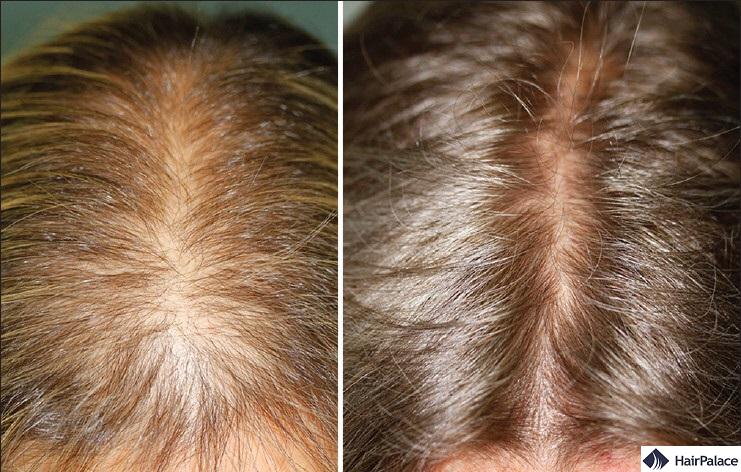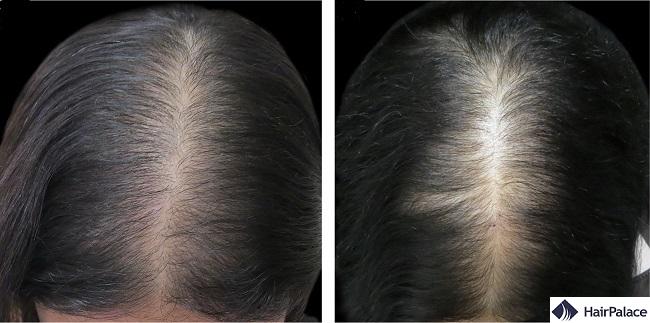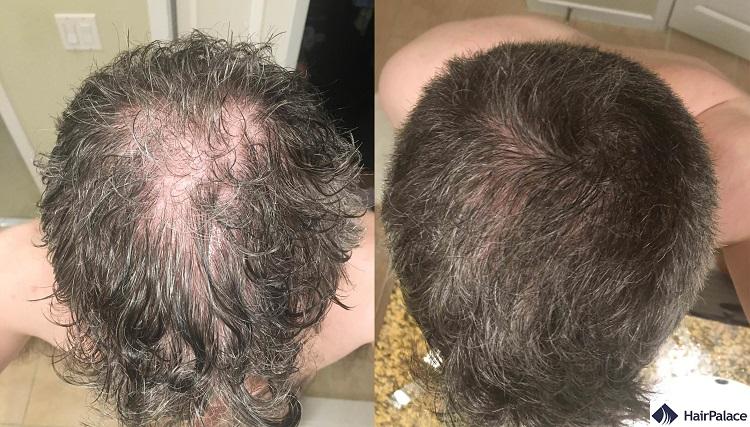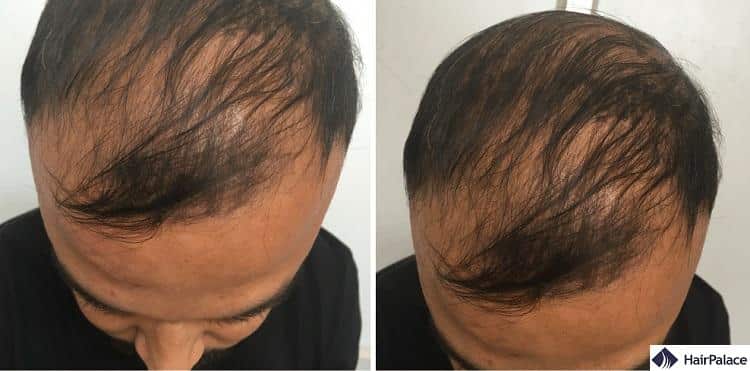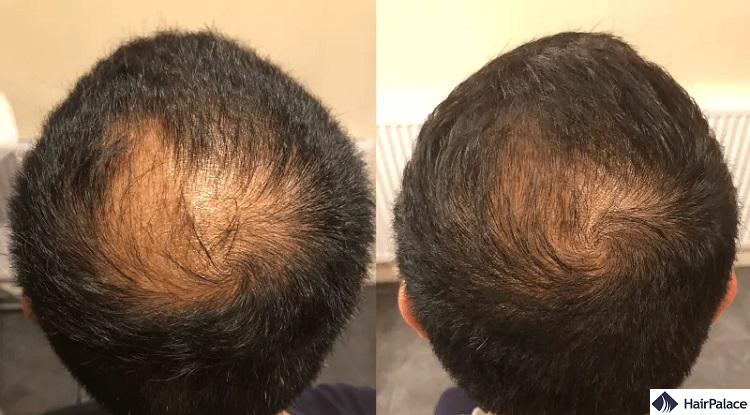Microneedling for Hair Loss: Does it Actually Work?
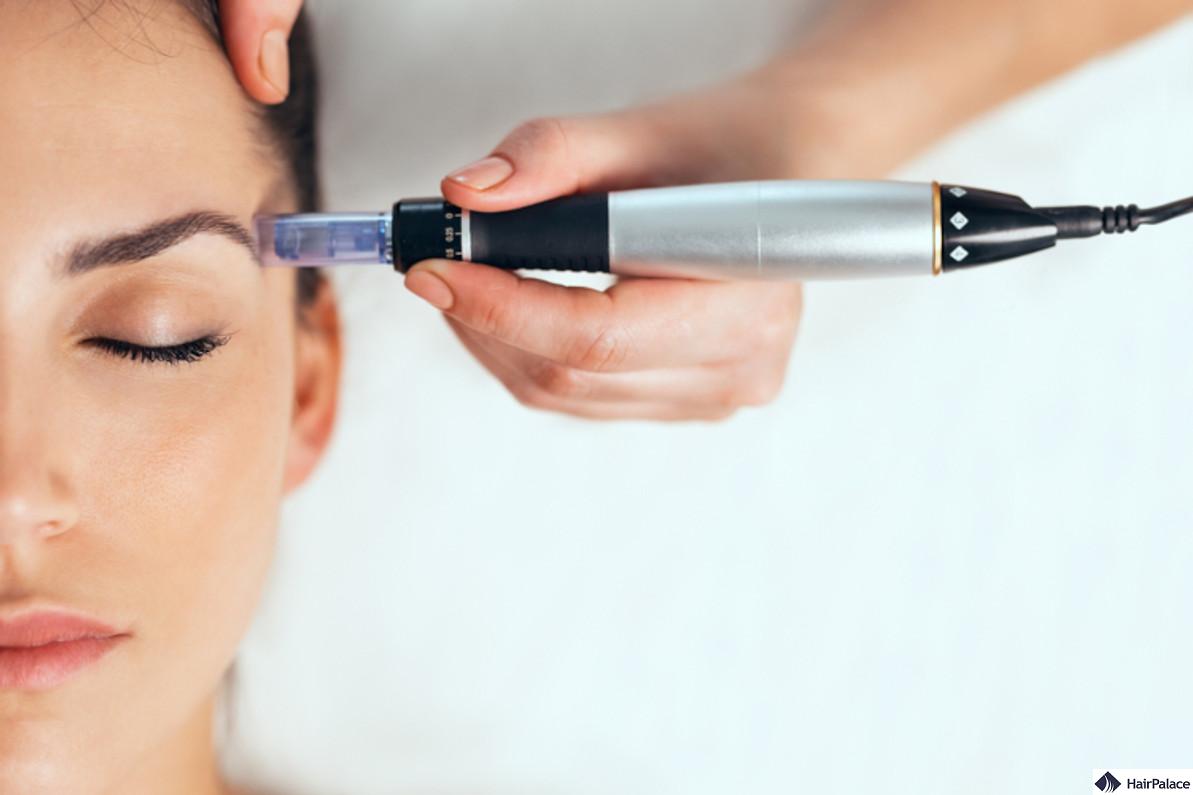
Quick, highly effective, and promising minimal downtime, microneedling has become one of the most popular anti-ageing treatments in the cosmetic industry.
Haircare specialists use fine needles to create tiny punctures in the skin stimulating the body’s natural wound healing response.
This leads to increased collagen and elastin production, improved skin texture, reduced scars, and new hair growth.
For hair loss, microneedling is often combined with topical treatments like minoxidil to enhance absorption and effectiveness.
Today, we will explain how the procedure works, share tips on finding the best practitioner and help you determine if this treatment is right for you.
- What is it?
- Does it work?
- Benefits
- Results
- Side effects
- Costs
- How to choose your practitioner
- Conclusion
What is microneedling for hair loss?
Microneedling is a treatment that uses a series of tiny needles to puncture the scalp to promote growth factors in the skin.
These small wounds trigger a healing response, stimulating collagen and elastin production.
More collagen and elastin trigger hair regeneration, as dormant hair follicles are encouraged to reactivate, thus creating the ideal conditions for hair growth.
Additionally, these tiny wounds are thought to help combat scalp inflammation, improve blood flow, and improve the quality and texture of existing hair.
Over time, microneedling may improve the hair count in balding areas.
Although it may sound sore, the procedure is relatively painless and promises a much quicker recovery than invasive surgeries.
Practitioners may apply a numbing agent on your scalp to help ease any discomfort.
Depending on the severity of hair loss, you may need to undergo several sessions of microneedling to promote hair growth.
You can expect visible results as early as three months following hair microneedling treatment.
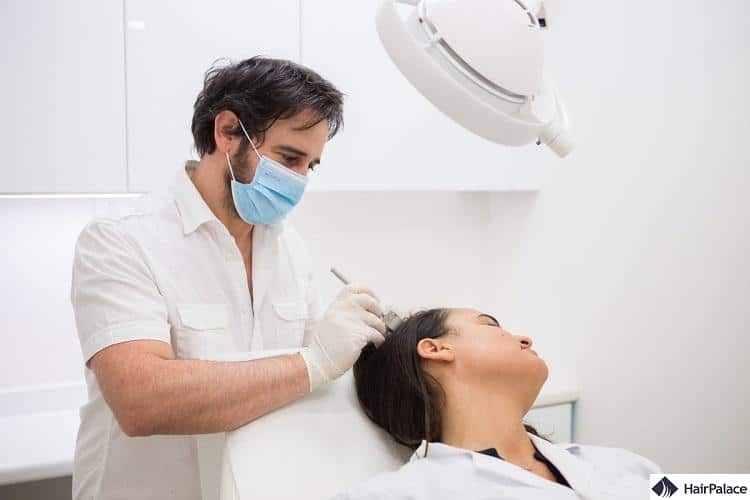
Does microneedling work against hair loss?
As well as being used to improve skin appearance, texture, and fullness, microneedling hair loss treatment is now a promising solution for hair loss.
Increased elastin and collagen production can effectively use your body’s resources to create ideal conditions for new hair growth.
Additionally, tiny wounds can help improve blood flow, reduce inflammation, and drastically improve the appearance and hair count in balding areas over time.
Microneedling can be used to help support or substitute conventional therapy.
For example, the treatment can be together with topical hair loss treatments so that your skin absorbs medication more effectively.
Conversely, drugs like Minoxidil and oral finasteride can have side effects that make them unsuitable for some patients. Microneedling offers a low-risk alternative to consider.
Many professionals compare it with another treatment, Platelet Rich Plasma injections (PRP).
Both aim to reactiveate dormant follicles by promoting cell regeneration.
It’s common for both treatments to be used together for maximum results.
One of the primary weaknesses of microneedling is that it is still a relatively new treatment, especially when compared to rival therapies.
A lack of long-term scientific research means we still do not know this treatment’s long-term effects or efficacy.
5 benefits of microneedling for hair
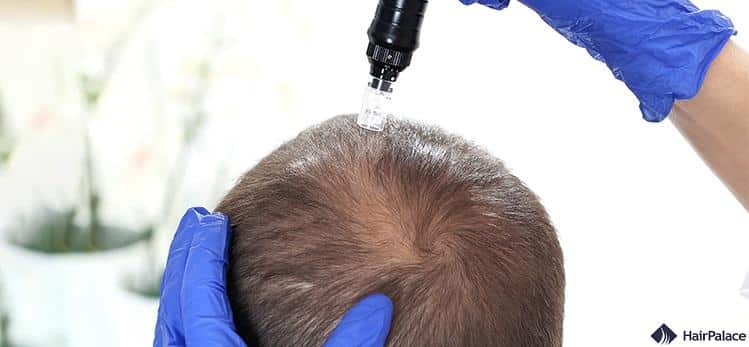
Despite this lack of research, many professionals are optimistic about the potential of microneedling treatment.
It is already hailed as a wonder treatment for several skin conditions, including wrinkles, acne scarring, and stretch marks.
Below are 5 of the main benefits of undergoing microneedling for hair loss:
- Minimally Invasive: One of the main benefits of microneedling is that it is minimally invasive, with significantly fewer risks than rival procedures. It requires no anaesthesia and promises a speedy recovery.
- Improved texture & tone: Because this procedure stimulates increased collagen and elastin production, your skin will feel smoother, plumper, and healthier.
- Mask Acne Scarring: If you have acne scars across your skin, microneedling can trigger the healing process in your body to produce helpful collagen and elastin.
- Improved Absorption of Topical Treatments: Microneedling can prepare skin to become more receptive to other topical hair loss treatments, such as moisturizers, serums, creams, and hair loss medications like topical Minoxidil.
- Cost Effective: On average, microneedling is much more affordable than other skin treatments, like laser therapy or PRP (platelet rich plasma) treatment. Moreover, you can purchase a microneedling device and perform the treatment at home.
What is a microneedling for hair loss treatment like?
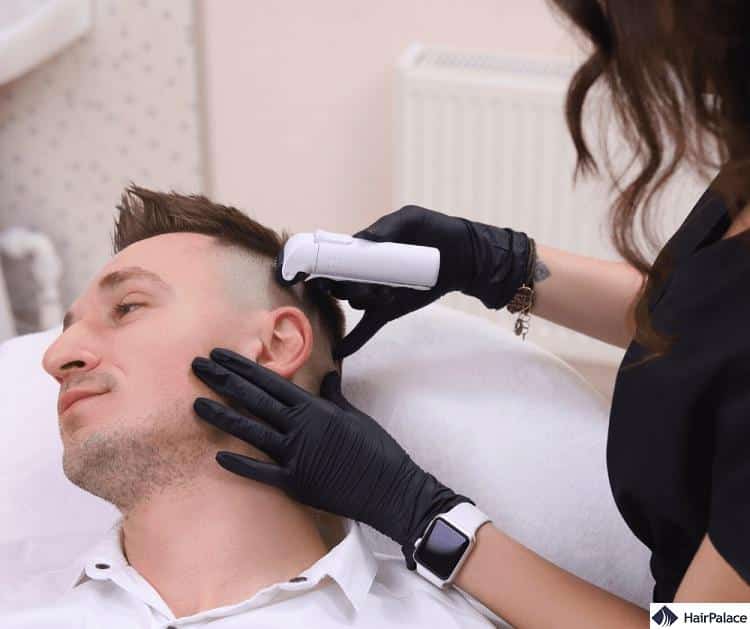
Microneedling is a relatively straightforward hair loss treatment that takes about 30 minutes to complete.
Generally, a topical numbing agent is applied to your skin beforehand to help alleviate pain and tenderness.
A unique device with tiny needles punctures the top layers of your skin.
These needles cause minor wounds across your skin, redirecting your body’s resources toward hair follicles.
Don’t worry – with the correct needle size, these wounds are controlled, and no lasting damage is caused to your skin’s epidermis or the hair follicles.
The needles are slowly moved across the entire scalp to create an even application.
The practitioner can adjust the needles relevant to your skin, hair loss, and extent of scarring.
For thicker hair density, it can take multiple spaced-out sessions and about 6 months.
Microneedling results
Microneedling is still a relatively new hair loss treatment, and research is ongoing to measure its effectiveness when used independently.
Until more formal studies have been conducted, we cannot say how truly effective it is or can be.
That said, some studies have shown promising microneedling for hair loss results when used in tandem with other treatments, like topical Minoxidil.
It is thought that microneedling can help promote even better blood circulation and cell regeneration.
Microneedle after hair transplant might be especially beneficial to get the most out of both treatments.
Is microneedling safe for your hair?
Microneedling for hair restoration is considered a relatively safe procedure to promote hair growth.
Whether you have thinning hair or extensive androgenetic alopecia, this minimally invasive procedure promises a quick recovery.
That said, the success and safety of microneedling depend mainly on the qualifications and experience of the practitioner.
There are also some potential side effects that you should be aware of. If unsure if you’re a suitable candidate, consult your doctor or dermatologist beforehand.
Side effects of microneedling treatment
Generally speaking, microneedling benefits hair health, but there are still some potential side effects you should be aware of.
Firstly, microneedling is not recommended for areas of your scalp full of hair.
The needle can potentially damage any healthy hair shaft it comes in contact with.
The most common of these include redness, swelling, and minor bleeding around the treated areas of the skin.
These should disappear a few days following treatment and generally cause no real trouble.
There are, however, potentially some severe complications.
In some cases, patients might experience bruising in the surrounding areas, skin discolouration, scarring, and potential skin infections.
If the wrong needle is used, it can easily damage a hair shaft.
We recommend visiting a qualified practitioner with industry experience who can help reduce the likelihood of developing complications.
If you have any allergies, bring these to the attention of your practitioner, as you may have a bad reaction to the topical anaesthetic used on your skin.
Furthermore, if you suffer from skin conditions like eczema, rosacea, or psoriasis or have active acne in the area, microneedling can aggravate these conditions further.
Finally, following your treatment, your scalp skin may become more sensitive, especially to direct sunlight.
Apply sunscreen when outside to protect yourself from harmful UV rays.
Dermaroller at home vs Microneedling
Dermarollers are essentially microneedling devices used by people at home. They generally have a max needle length of 1 mm.
Despite their popularity, most skin experts still recommend going to a professional for microneedling.
Though more expensive, these professionals will have superior equipment and access to a wider variety of needle sizes, including 3 mm.
These longer needles can promote skin growth factors and yield better results.
Additionally, a professional will adhere to the best safety practices that will drastically reduce the likelihood of you developing complications.
How much does microneedling for hair loss treatment cost?
The price of microneedling can depend on several factors.
The most important is the size and scale of your treatment – the larger the area, the higher the costs involved.
Generally, a single treatment can range between £100-£500.
Clinics with highly qualified staff and great reputations often will charge a premium rate.
Because patients often require several sessions of microneedling, clinics may offer package deals that include multiple treatments at an overall reduced rate. Packages can range from £500-£1,500.
It’s important to note that quotes may not be all-inclusive.
You may have to pay for topical treatments, anaesthetic creams, aftercare products, and follow-up appointments.
We recommend researching and comparing several reputable clinics and their respective treatment packages for the best market price.
Additionally, you can ask your healthcare provider for their recommendations and advise you on how many sessions you might typically require.
5 useful tips to choose the right practitioner
The best microneedling results stem from the best practitioners.
And while most clinics can offer this service, there are some things to keep in mind when choosing where to go:
- Extensive research: Don’t just go with the first practitioner or clinic you find—research several competitors across various criteria, including price, availability, and aftercare services.
- Qualifications Some countries may not have regulations around microneedling. You must check the staff’s qualifications and certifications and their experience levels.
- Communication: Communication is critical to putting your mind at ease, like any medical treatment. Ensure that the clinic or practitioner you choose can discuss your treatment and address your concerns ahead of time.
- High-quality equipment: Pay close attention to the type of devices and needles the practitioner uses. The best professionals will only use medical-grade equipment and offer a wide variety of needle lengths for you to consider.
- Patient satisfaction: You can gauge the quality of work a clinic can do by reading previous customers’ testimonials. Often clinics have photo galleries that can give you an idea of possible results.
Conclusion
Unsurprisingly, microneedling has become a popular treatment for various skin and hair loss conditions.
The controlled wounds the needles make promote healthy cell regeneration, improve skin texture, and potentially help regrow hair.
It’s a versatile treatment perfectly capable of treating everything from hair thinning to male and female pattern hair loss.
And because it is a minimally invasive cosmetic procedure, it offers a quicker recovery than surgical options like hair transplant surgery.
That said, the microneedling industry is still in its infancy.
Most of the positive research found it beneficial in supporting other treatment types, like topical medications.
On its own, we still don’t know just how effective or long-term the treatment is.
Until more research has been conducted, we recommend consulting with your doctor or dermatologist on whether microneedling will effectively address your hair loss.
Microneedling FAQ
Microneedling can be effective for hair loss. It stimulates the scalp and can promote hair growth by increasing blood flow and nutrient delivery to hair follicles. However, results can vary and it’s often used in conjunction with other treatments.
Microneedling, when done correctly, typically does not damage hair follicles. It’s designed to stimulate the scalp and promote hair growth. However, if performed improperly or with needles that are too long, it could potentially cause harm.
You can wash your hair after microneedling, but it’s generally advised to wait at least 24 hours to allow the scalp to recover and prevent irritation.
Microneedling for hair growth is typically done every 2 to 4 weeks, depending on your skin’s healing response and the severity of hair loss. Consult a dermatologist for personalized guidance.
Microneedling can be effective for hair growth by stimulating collagen production and increasing scalp absorption of topical treatments. Studies show improved hair density and thickness, especially when combined with treatments like minoxidil. Results vary by individual.
Last medically reviewed on January 16th, 2025
- Dhurat R, et al. (2013). A randomized evaluator blinded study of effect of microneedling in androgenetic alopecia: A pilot study.https://doi.org/10.4103/0974-7753.114700
- Fertig RM, et al. (2017). Microneedling for the treatment of hair loss? https://www.ncbi.nlm.nih.gov/pubmed/29194786
- Kim YS, et al. (2016). Repeated microneedle stimulation induces enhanced hair growth in a murine modelhttps://anndermatol.org/DOIx.php?id=10.5021/ad.2016.28.5.586
- Iriarte, C., Awosika, O., Rengifo-Pardo, M. & Ehrlich, A. (2017). Review of applications of microneedling in dermatology. Clinical, Cosmetic and Investigational Dermatology. https://www.ncbi.nlm.nih.gov/pmc/articles/PMC4976400/

